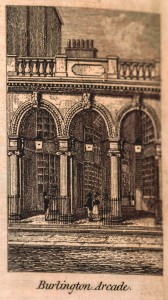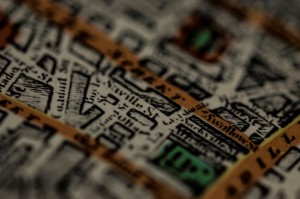Two years before Burlington Arcade opened, the Gentleman’s Magazine published an article describing some of the reasons for its construction:
It is said that after numerous deliberations, Lord George Cavendish [1st Earl of Burlington] has determined to appropriate a proportion of the grounds connected with Burlington House for the gratification of the publick, and to give employment to industrious females…What first gave birth to the idea was the great annoyance to which the garden is subject from the inhabitants of a neighbouring street throwing oyster-shells, &c., over the wall. The intended erections will prevent these nuisances in future and also block out their view of so delightful a place. (Gentleman’s Magazine, Sept. 1817, p. 272)
Going beyond the fact that Burlington Arcade served Lord Cavendish as a garden fence – a very ornate one, mind you – later visitors understandably commented on its merits as a fashionable, commercial space. In the 1822 edition of Samuel Leigh’s New Picture of London, the author states how Burlington Arcade, ‘is a handsome covered avenue…containing 72 genteel shops’ while during a trip to London, the Polish philosopher, Krystyn Lach-Szyrma (1790–1866) noted how:
High society only frequent places dedicated to fashion…a similar sight can be seen in Burlington Arcade in Bond Street, which is built in the shape of a long gallery lined on both sides with shops…
Both works, however, comment emphatically how the arcade is flanked by two doormen, ‘to keep out improper visitors.’
Turning away from these descriptive sources, the library’s collection of London directories allows a glimpse into who was trading in the arcade. Looking at Robson’s London Commercial Directory…for 1830, for example, we can see most of the shops specialised in the luxury clothing trade: listed were nine hosiers, two ladies shoe makers, eight milliners, two boot makers and one haberdasher. Moreover, although the directory only provides us with a list of names and their trade, one can make cautious, but educated guesses about some of the traders: at No. 15 Burlington Arcade was the hosier David Peden who also had another outlet on 228 Regent St. – presumably quite a successful retailer, while at No. 40 was the milliner Eliza Rainger, whose shop was next door to the jeweller, Frederick Raigner – possibly a late Georgian husband and wife business team?
Looking beyond Burlington Arcade to the streets to the north, the library’s directories reveal something of the early history of tailoring in Mayfair. Although Savile Row is now synonymous with luxury, bespoke tailoring, this was not always the case. According to Johnstone’s London Commercial Guide for 1817 Savile Row (or Street as it was still known) was the haunt mainly of medical professionals. It was nearby Cork Street where many tailors decided to trade. This trend is confirmed in Pigot’s Directory, 1826-7 and Robson’s London Directory, 1830 and 1835. However one does start to see a rise from 1830 (in 1830 four tailors were based in Savile Row, in 1835 this had risen to seven). Interestingly one of those listed, trading at No. 32 Savile Row was James Poole, whose son, Henry Poole (1814–1876) would go on to mark Savile Row as the destination for luxury tailoring in Victorian Britain and also invent the dinner jacket in 1865 for his friend, Bertie, the Prince of Wales.
Marking this year’s Anglo-American Conference on Fashion History the library has produced a number of other posts and guides: see Alex Zaleski’s entertaining blog post on Fashion in travel writing and Kate Wilcox’s thorough subject guide and accompanying blog post on the largely hidden, but extensive resources the library has on this subject.


